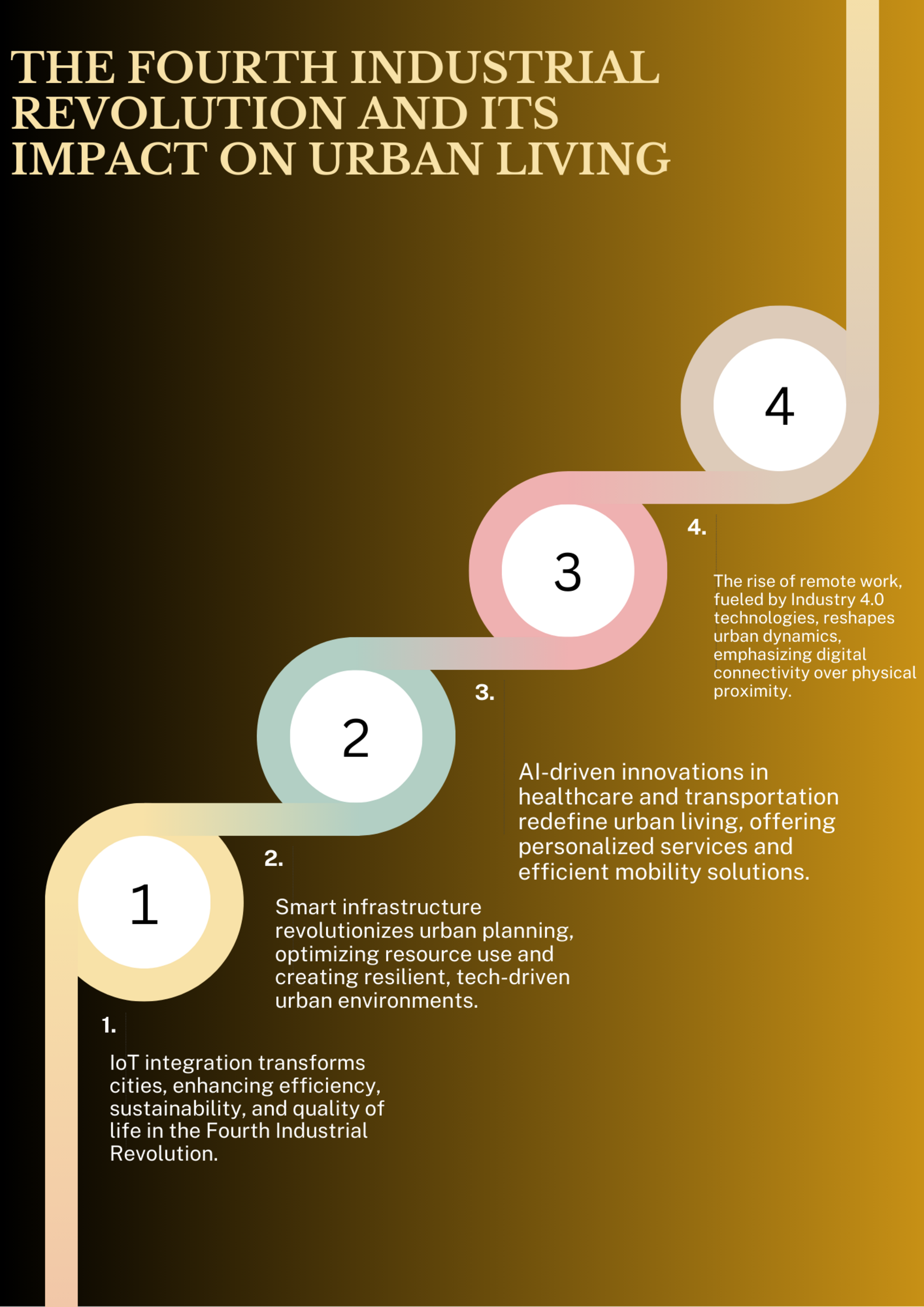The Fourth Industrial Revolution, a term coined by Klaus Schwab, founder and executive chairman of the World Economic Forum, signifies an era where technology is blurring the lines between the physical, digital, and biological spheres. This unprecedented revolution is not merely changing what we do but fundamentally altering who we are, influencing all disciplines, economies, and industries, and even challenging our understanding of what it means to be human.
One of the most significant areas impacted by the Fourth Industrial Revolution is urban living. As cities become the epicenters of human population and activity, the way they function and evolve is being radically transformed by emerging technologies. From smart, sustainable cities to dramatic shifts in work styles and lifestyle, the Fourth Industrial Revolution is reshaping the very fabric of urban life.
In this blog post, we will delve into how the Fourth Industrial Revolution is impacting urban living. We’ll explore how it’s driving the rise of smart cities, transforming work and lifestyle patterns, and what this means for the future of urbanization. So, whether you’re a city dweller curious about the future of your metropolis or an urban planner seeking insights on leveraging technology, this blog post offers a comprehensive look at the intersection of the Fourth Industrial Revolution and urban living.
Understanding the Fourth Industrial Revolution
The Fourth Industrial Revolution, frequently referred to as Industry 4.0, heralds a new phase in the evolution of human progress. This era is characterized by the unprecedented pace and scale of technological advancements that are fundamentally transforming all aspects of life. Unlike previous industrial revolutions, which were driven by steam power, electricity, and information technology, respectively, the Fourth Industrial Revolution is marked by a fusion of technologies that erase the boundaries between the physical, digital, and biological worlds. Technologies such as artificial intelligence (AI), robotics, the Internet of Things (IoT), autonomous vehicles, 3D printing, nanotechnology, biotechnology, quantum computing, and more, are not merely changing the way we work or do business, but also how we live, communicate, and interact.
Advancements in AI and machine learning are empowering machines to learn from experience, adjust to new inputs, and perform human-like tasks. From voice assistants like Siri and Alexa to more complex technologies such as autonomous cars, AI is becoming an integral part of our daily lives.
However, the Fourth Industrial Revolution also brings challenges. Issues around privacy, cybersecurity, and the future of work are some of the pressing concerns that need addressing. As we navigate this new era, it’s crucial for businesses, governments, and individuals to understand the potential of these technologies and to work together to ensure they are harnessed for the greater good.
Rise of Smart Sustainable Cities
The concept of Smart Sustainable Cities is gaining momentum globally as we navigate the Fourth Industrial Revolution. These cities leverage Information and Communication Technologies (ICTs) and other innovative methods to enhance the quality of life, improve the efficiency of urban operations and services, and ensure environmental sustainability.
As urbanization increases worldwide, there’s a rise in technology spending on smart city programs and infrastructure. This development is driving the growth of smart cities, reshaping urban living by making it more efficient and sustainable. Smart growth, an approach to urban planning, aims to foster sustainable communities through efficient and innovative urbanizations. The focus of this planning approach is to design cities that are economically viable and environmentally friendly, reducing the overall carbon footprint.
In the era of the Fourth Industrial Revolution, smart cities are seen as urban innovations that advance, harness, and integrate physical and digital infrastructures. They change urban planning, engineering, and design, involving multiple disciplines and technologies, to promote inclusive and sustainable growth. The Internet of Things (IoT) plays a crucial role in the rise of smart cities. By connecting various devices and systems, IoT streamlines city operations, minimizes environmental impact, and improves the overall efficiency of urban life.
The future of Smart Sustainable Cities looks promising. According to the United Nations, smart cities are expected to witness steady growth given their role in securing global sustainability. By 2050, they are predicted to play an even more significant role in urban living.
Changing Work Styles in the New Era
The Fourth Industrial Revolution is bringing a significant shift in the nature of work and work styles. With advancements in technology such as artificial intelligence (AI), automation, and robotics, the workforce is experiencing a transformation that is unparalleled. Traditional job roles are evolving and, in some cases, becoming obsolete. As machines take over repetitive tasks, the demand for manual labor is reducing. However, this does not necessarily mean a reduction in jobs. Instead, it’s leading to a shift in the type of work that humans do.
The new era is giving rise to jobs that didn’t exist a few years ago. Roles like AI specialists, data scientists, and cybersecurity experts are in high demand. The emphasis is increasingly on skills such as critical thinking, creativity, and emotional intelligence, which machines cannot replicate.
Flexible work arrangements are also becoming more common. Remote work, freelance work, and flexible working hours are being adopted by many businesses. This is made possible by digital technologies that allow people to work from anywhere at any time.
In summary, the Fourth Industrial Revolution is transforming work styles in profound ways. It’s creating a more flexible, adaptable, and skilled workforce that is prepared to navigate the challenges and opportunities of the new era.
Lifestyle Transformation Under the Fourth Industrial Revolution
The Fourth Industrial Revolution, characterized by the fusion of digital, physical, and biological technologies, is not just transforming industries and economies; it’s also reshaping lifestyles in unprecedented ways.
Technology has become an integral part of everyday life. Smartphones, wearable tech, and connected devices are providing individuals with access to information, products, and services at an unprecedented scale and speed. This connectivity is transforming how we communicate, shop, learn, travel, and entertain ourselves.
The rise of AI and machine learning is leading to personalized experiences. From product recommendations based on browsing history to customized news feeds, technology is enabling more tailored and relevant experiences. Moreover, voice-activated virtual assistants like Amazon’s Alexa, Google’s Assistant, and Apple’s Siri are making technology interaction more natural and intuitive.
In terms of health and wellness, advancements in biotechnology and wearable devices are revolutionizing healthcare. Wearable fitness trackers monitor vital signs in real-time, encouraging healthier lifestyles. Telemedicine is enabling remote patient monitoring and consultations, improving access to healthcare services.
However, the lifestyle transformation under the Fourth Industrial Revolution also brings challenges. Digital addiction, privacy concerns, and the potential for job displacement due to automation are significant issues that society needs to address.
Furthermore, the digital divide between those with access to technology and those without could exacerbate social inequalities. As such, it’s crucial to ensure that the benefits of the Fourth Industrial Revolution are accessible to all, not just a privileged few.
The Role of Industry 4.0 Technologies in Urbanization
Industry 4.0, or the Fourth Industrial Revolution, is characterized by the fusion of physical and digital technologies such as Artificial Intelligence (AI), Internet of Things (IoT), robotics, and big data analytics. These technologies play a pivotal role in the urbanization process, contributing to the development of smart, sustainable cities.
- Internet of Things (IoT): IoT devices collect data from various sources in real time, enabling city administrators to monitor and manage infrastructure efficiently. For example, IoT-enabled sensors can provide real-time data on traffic flow, air quality, waste management, and energy usage, leading to more efficient operations and improved public services.
- Artificial Intelligence (AI) and Big Data: AI and big data analytics can process vast amounts of data collected by IoT devices, providing actionable insights for decision-making. This can enhance urban planning, transportation management, and emergency response. AI can also be used to power chatbots for public services, improving citizen engagement.
- Robotics: Robotics can automate various city services, from garbage collection to maintenance tasks. For instance, automated street sweepers and robotic waste sorting systems can improve efficiency and reduce the environmental impact of waste management.
- Blockchain Technology: Blockchain can enhance transparency and security in urban operations. It can be used in land registry management, supply chain tracking, and even voting systems, ensuring data integrity and reducing fraud.
- 5G Technology: The high speed and low latency of 5G networks enable real-time data processing and communication between devices. This is crucial for the operation of autonomous vehicles, smart grids, and other applications that require real-time data.
Future Implications: The Next Stage of Urban Living
As we move into the future, urban living will continue to evolve under the influence of technology, changing demographics, and environmental considerations. This evolution will have several implications:
- Smart Cities: With advancements in technologies like IoT, AI, and 5G, cities will become smarter and more connected. Sensors and data analytics will be used to manage traffic, reduce energy consumption, enhance public safety, and improve quality of life. However, this will also raise issues related to data privacy and security.
- Sustainable Living: As concerns about climate change grow, there will be a greater focus on sustainable living. This could involve green building practices, renewable energy sources, efficient waste management, and promotion of public transportation or electric vehicles. Urban farming might also become more prevalent to promote local food production and reduce carbon footprint.
- Compact Living: With increasing urban population, space will become a premium. This could lead to more compact and efficient housing designs. Co-living or shared living spaces might become more common. There will also be a greater emphasis on multi-use spaces that can serve various functions.
- Digital Divide: As cities become more digitized, there’s a risk of widening the digital divide. Those who cannot afford or access digital technologies might be left behind. Therefore, ensuring digital inclusivity will be a crucial aspect of urban planning.
- Health and Well-being: The COVID-19 pandemic has highlighted the importance of health and well-being in urban design. In the future, there might be more emphasis on creating spaces that support physical activity and mental health. This could include more parks, bike lanes, and pedestrian-friendly streets.
In conclusion, the next stage of urban living will be characterized by smarter, more sustainable, and inclusive cities. However, these transformations also bring challenges that need to be addressed to ensure a better urban future for all.



